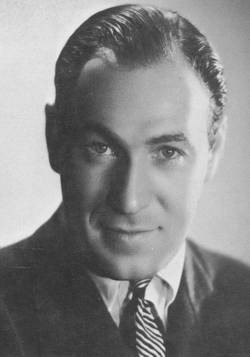Buddy Clark facts for kids
Quick facts for kids
Buddy Clark
|
|
|---|---|

Clark in a 1942 advertisement
|
|
| Background information | |
| Birth name | Samuel Goldberg |
| Born | July 26, 1912 Boston, Massachusetts, U.S. |
| Died | October 1, 1949 (aged 37) Los Angeles, California, U.S. |
| Genres | Traditional pop |
| Years active | 1934–1949 |
| Labels | Columbia |
Buddy Clark (born Samuel Goldberg, July 26, 1912 – October 1, 1949) was a popular American singer. He was famous during the Big Band era. This was a time when large musical groups played jazz and pop music.
Buddy Clark became very successful in the late 1940s. He was known as a top crooner. A crooner is a male singer who sings in a soft, smooth style. Sadly, he died in a plane crash in 1949.
Contents
Life and Career
Buddy Clark was born in Dorchester, Massachusetts. His parents were Tillie and Nathan Goldberg. He started singing with Gus Arnheim's orchestra in 1932. At first, he sang as a tenor, which is a high male voice. This wasn't very successful for him.
In 1934, he switched to singing baritone, a lower male voice. This helped him gain more attention. He performed with Benny Goodman on the Let's Dance radio show. From 1936 to 1938, he was on the popular show Your Hit Parade. He also signed with Vocalion Records. His song "Spring Is Here" became a top-20 hit. Buddy Clark also appeared in movies and sang for other actors.
After serving in World War II, his career really took off. In 1946, he joined Columbia Records. He had his biggest hit with the song "Linda". This song was written for the six-year-old daughter of a lawyer named Lee Eastman. That daughter, Linda Eastman, later married Paul McCartney from The Beatles.
In 1947, Buddy Clark had many more hits. These included "How Are Things in Glocca Morra?" and "Peg O' My Heart". He also sang "An Apple Blossom Wedding" and "I'll Dance at Your Wedding." The next year, he had a huge hit with "Love Somebody." This was a duet with the famous singer Doris Day. It sold a million copies and reached number one on the music charts.
Buddy Clark continued to have hits in 1949. He sang both by himself and with Doris Day and Dinah Shore. He was also the narrator for the Disney movie Melody Time in 1948. A month after he passed away, his song "A Dreamer's Holiday" became a hit.
Death and Legacy
On October 1, 1949, Buddy Clark had just finished a radio show called Club Fifteen. He was filling in for Dick Haymes and sang with The Andrews Sisters. After the show, the 37-year-old singer and five friends rented a small plane. They were going to a college football game in Stanford, California.
On their way back to Los Angeles, the plane ran out of fuel. It lost height and crashed on Beverly Boulevard in West Los Angeles. Buddy Clark did not survive the crash.
Buddy Clark is buried at Forest Lawn Memorial Park in Glendale, California. He had two children, Tommy and Katherine.
Jerry Vale's first album, I Remember Buddy (1958), was a tribute to Buddy Clark. For his important work in music, Buddy Clark has a star on the Hollywood Walk of Fame. You can find it on 6800 Hollywood Boulevard.
Hit songs
- "An Apple Blossom Wedding" (1947)
- "Baby, It's Cold Outside" (1949) (Duet with Dinah Shore)
- "Ballerina" (1948)
- "Confess" (1948) (Duet with Doris Day)
- "Don't You Love Me Anymore" (1947)
- "A Dreamer's Holiday" (1949)
- "Girl Of My Dreams" (with Mitchell Ayres and His Orchestra)
- "How Are Things in Glocca Morra?" (1947)
- "I'll Dance at Your Wedding" (1947)
- "I'll Get By (As Long as I Have You)" (with Mitchell Ayres & His Orchestra)
- "I Love You So Much It Hurts" (1949)
- "It's a Big, Wide, Wonderful World" (1949) (with Mitchell Ayres and His Orchestra)
- "Linda" (1947)
- "Love Somebody" (1948) (Duet with Doris Day)
- "Matinee" (1948)
- "May I Have the Next Romance?" (1936)
- "My Darling, My Darling" (1948) (Duet with Doris Day)
- "Now Is the Hour" (1948)
- "Peg O' My Heart" (1947)
- "Powder Your Face with Sunshine" (1949) (Duet with Doris Day)
- "Rosalie" (with Mitchell Ayres & His Orchestra)
- "The Rhythm of the Rhumba" (Duet with Joe Host and the Lud Gluskin orchestra) (1936)
- "Serenade" (1948)
- "She Shall Have Music" (1936)
- "South America, Take It Away!" (with Xavier Cugat and His Orchestra)
- "Spring Is Here" (1938)
- "Take My Heart" (1936)
- "These Foolish Things" (1936)
- "These Things Money Can't Buy" (1947)
- "The One I Love (Belongs to Somebody Else)"
- "The Treasure of Sierra Madre" (1948)
- "Until Today" (1936)
- "Where the Apple Blossoms Fall" (1948)
- "You Are Never Away" (1948)
- "You're Breaking My Heart" (Orchestra & Chorus Conducted by Harry Zimmerman)
See also
 In Spanish: Buddy Clark para niños
In Spanish: Buddy Clark para niños

